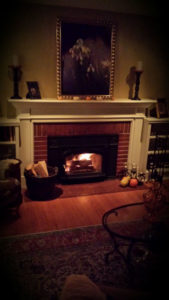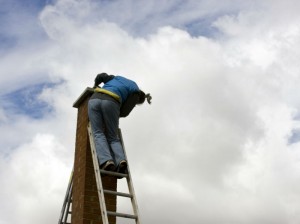During the cold months of winter, homeowners rely on their fireplaces to work day in and day out in order to provide warmth and comfort in their homes. However, few us of truly understand the inner workings of our chimney and fireplace systems; because of this, small damage or performance problems may go unnoticed for months – or years – at a time.
Because few of us spend much time on our roofs or looking up the flue, chimney damage often goes unnoticed until a chimney inspection. A chimney inspection done by a certified chimney professional can assess the state of your fireplace system, identify areas of damage or deterioration, and allow recommendation for repairs to be made.
Levels of chimney inspection
The Chimney Safety Institute of America (CSIA)] and the National Fire Protection Agency (NFPA) created three standard levels of chimney inspections; the type of chimney inspection your home needs will depend on its condition, time since last maintenance, or performance problems it may be experiencing.
- Level 1: Level 1 chimney inspections are standard and all that is needed for most homes. During a Level 1 inspection, the chimney sweep will check the accessible interior and exterior portions of the fireplace and chimney for signs of damage or deterioration.
- Level 2: Level 2 chimney inspections are more in-depth, typically involving the use of technology such as closed-circuit cameras. Level 2 inspections are often recommended in real estate transactions or when the fuel source of a fireplace has been changed.
- Level 3: Level 3 chimney inspections are the most in-depth and only recommended when the structural stability of the chimney is in question, such as after a chimney fire or natural disaster. A portion of the masonry or walls may need to be removed during a Level 3 inspection.
Common issues uncovered in chimney inspections
- Every fireplace system and every chimney inspection are unique; however, there are a number of common issues that are often uncovered during an inspection. The following are three of the most common chimney issues uncovered during inspections.
- Water damage. Chimneys are built to withstand exposure to moisture, but it can still be extremely damaging to a fireplace system. Damaged chimney caps, cracks in the exterior masonry, or damaged flashing are just a few of the many ways water can get into a chimney.
- Cracked chimney crown. Chimney crown damage is extremely difficult to spot without climbing onto the roof or chimney. The flat masonry of the chimney crown bears the brunt of the exposure to the elements; changes in temperature or exposure to moisture can cause the chimney crown to crack over time.
- Damaged chimney liner. The chimney liner protects the surrounding building materials from heat transfer from the fireplace. Liners can become damaged from animal entry, leaks, lack of maintenance, or debris in the chimney.
Preventative maintenance is one of the best ways to extend the life of our fireplaces and chimneys. An annual chimney inspection done by a certified chimney professional can uncover hidden issues that many homeowners might not otherwise notice. For more information on the importance of chimney inspections or to schedule your next chimney appointment, contact Jack Pixley Sweeps today!
 Temperatures are finally starting to cool down and fall finally feels like it’s here! With the busy burning season just around the corner, many homeowners are preparing to light their fireplaces for the first time. Before you use your fireplace for the first time this year, however, make sure to have it inspected first!
Temperatures are finally starting to cool down and fall finally feels like it’s here! With the busy burning season just around the corner, many homeowners are preparing to light their fireplaces for the first time. Before you use your fireplace for the first time this year, however, make sure to have it inspected first!
The importance of chimney inspections
Chimney inspections are an important diagnostic tool that chimney sweeps use to evaluate the condition of your fireplace system.
“A chimney inspection is like an annual dental check-up,” says Ashley Eldridge, Director of Education for the Chimney Safety Institute of America. “It’s preventative maintenance that helps minimize potential hazards.”
Inspections often allow chimney sweeps to identify small areas of damage or deterioration – long before they turn into major chimney problems. This allows small, less expensive repairs to be made as needed instead of needing major masonry or structural repairs all at once.
Three levels of chimney inspections
The National Fire Protection Association created three standardized levels of chimney inspection. Your chimney sweep can help determine what kind of inspection your chimney needs based on age, use, and other factors.
- Level 1 chimney inspections are the most basic; during this type of inspection, the chimney sweep will evaluate all accessible portions of both the interior fireplace and exterior chimney. Level 1 inspections are used in homes where the chimney is regularly maintained, has not been changed since the last inspection, and is not experiencing performance issues.
- Level 2 chimney inspections are more in depth and often involve the use of technology – such as closed circuit cameras – in order to check difficult to reach areas of the chimney such as the flue. Level 2 inspections are common when a new insert has been installed, a new fuel source is being used, or a home is preparing to be bought or sold.
- Level 3 chimney inspections are the most intense and often involve removing part of the masonry or surrounding building material in order to access the chimney; because of this, they are only used in the event of natural disasters, fires, or if the structural stability of the chimney is in question.
What if I don’t use my fireplace?
Regular fireplace maintenance – including chimney sweepings and inspections – are important no matter how often you use your fireplace. In fact, having an inspection done before lighting a fireplace that is seldom used may be even more important. Infrequently used fireplaces are more likely to suffer from problems such as animal entry or debris blockages; because these and other similar issues often present themselves in the form of performance problems, they may not be immediately noticed in a fireplace that is not regularly used.
The National Fire Protection Association and the Chimney Safety Institute of America both recommend that homes have their fireplaces and chimneys inspected at least once per year. Doing this ensures your fireplace is safe to use – no matter how often you use it.
If you are getting ready to start your fireplace for the first time, make sure to have your chimney inspected first. Contact Jack Pixley Sweeps today to schedule your next chimney inspection before you start using your fireplace!
If your home has a chimney, you’ll have to have it cleaned sooner or later; it’s recommended that you have it done yearly at the very least. The National Fire Protection Association (NFPA) and Chimney Safety Institute of America (CSIA) classify chimney inspections into three categories: Level 1, Level 2, or Level 3. Each level of inspection covers specific items depending on the equipment and how it is vented to the outside of your home. Taking an in-depth look at all three levels will give you a clearer understanding of what’s completed during each and how each subsequent level builds on the work completed during the previous level(s).

Having your chimney inspected and cleaned annually helps minimize any safety risks and maximizes performance.
Levels of Inspection
1.Level 1 – these are completed during a routine chimney cleaning and, as such, should be carried out annually. This more routine level of evaluation is the recommended course of action when the conditions of use have not changed over the past year. These inspections are limited in scope to the portions of the chimney’s exterior and interior that are easily accessible as well as the portions of the fireplace and flue that are readily accessible. The technician will look to gauge the condition of the flue and chimney structure as well as your basic fireplace installation and connections. The technician will also check to make sure that the chimney is free of obstructions and combustible deposits.
2.Level 2 – these are more detailed and thorough than the previous level and are recommended either when the conditions of use have changed during the past year or when a Level 1 inspection revealed an issue that warrants a more thorough inspection. A few notable issues that may call for a more in-depth inspection are homeowners opting to convert their traditional fireplace to a gas unit or when an event has occurred that could have compromised the chimney in some way (e.g., chimney fire, earthquake, or foundation settling). It’s also recommended upon the sale or transfer of the property. These inspections include everything a Level 1 inspection would include as well as the inspection of accessible areas of the attic, basement, and crawlspace and a video evaluation of the inside of your chimney.
3.Level 3 – these are the most in-depth of all the inspection types and are conducted after either a Level 1 or Level 2 inspection has revealed a major issue in parts of the chimney and/or flue that are not easily accessible. These inspections include all of the areas covered in Level 1 and Level 2 inspections as well as inspection of otherwise concealed areas to further investigate known or suspected problems. Because certain portions of Level 3 inspections require some sort of demolition to, within, or around your home, the technician will discuss this work with you prior to beginning anything.
That’s a lot of information to pack into one blog. The information is, however, extremely important. Understanding the general scope of work required with each level of inspection is critical to being an informed homeowner and consumer. We want all of our customers to be pleased with the work we do and not to be blindsided by the costs that go along with it. We wish you a happy and safe holiday season.

 Temperatures are finally starting to cool down and fall finally feels like it’s here! With the busy burning season just around the corner, many homeowners are preparing to light their fireplaces for the first time. Before you use your fireplace for the first time this year, however, make sure to have it inspected first!
Temperatures are finally starting to cool down and fall finally feels like it’s here! With the busy burning season just around the corner, many homeowners are preparing to light their fireplaces for the first time. Before you use your fireplace for the first time this year, however, make sure to have it inspected first!